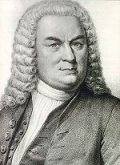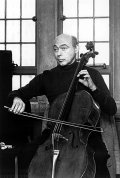
Johann Sebastian Bach
Almost every great cellist of the twentieth century has recorded Johann Sebastian Bach's six
Suites for Solo Cello. It is a task so daunting that the famous Russian cellist Mstislav Rostropovich only felt himself worthy of the feat at the age of 68 in his much anticipated
1995 recording, legendary even before its release.
The
Solo Cello Suites are perhaps the cellist's equivalent of climbing Everest, or more accurately, reaching enlightenment. It takes prodigious talent and a lifetime of study.
All music is communication - the composer speaking to the audience, conveying an emotional, intellectual state. A solo instrument recital is the most direct, the most intimate; almost embarrassingly confronting. Especially the cello, possessing as it does the most human-like sound of all instruments.
It is this intimacy that has made the
Solo Cello Suites amongst Bach's most popular works, and its different interpretations most fiercely defended by their respective advocates. Everybody has their favourite performance. We risk “stoning by email” for proposing any version as the best. That's not we aim to do.

Pablo Casals
Early in the twentieth century, Bach's
Cello Suites were virtually unknown. Some cellists used them as technical exercises, but never for performing in public.
In 1933, the great Spanish cellist Pablo Casals brought them out of didactic obscurity. He recognised the wonderful genius of feeling, melody and technical virtuosity within them. It became his signature piece on stage, and his
original recording is still available.
Since then, of course, it has become a familiar, almost required, set for all cellists. Since Casals, there have been recordings by Pierre Fournier, Anner Bylsma, Paul Tortelier, Rostropovich, Yo-Yo Ma (twice), Pieter Wisplewey, Jacqueline du Pre (sadly not a complete set) and the cellist featured here, Janos Starker.
The Baroque Suite
The
Suite was the first purely instrumental form of music. Out of it grew all the others; the sonata, the symphony, the concerto etc.
It had its origins in the Middle Ages when lutenists fashioned a cycle out of the popular dances of the time. Gradually the movements became more abstract and stylized, but still retained the rhythms and structures of the original dances.
By Bach's time, these works had become so abstract that they were never meant to be literally danced. Except perhaps as dances of the mind.
The traditional baroque suite contains four sections:
- Allemande - German dance in 4/4 time with an ornamental melodic line.
- Courante - A light and quick French dance. Courante means flowing.
- Sarabande - a slow, almost mournful Spanish dance.
- Gigue - a lively dance from England in triple time.
To this unvarying structure, Bach added an artistically free
Prelude to the beginning and a bright, fast moving movement between the
Sarabande and the
Gigue. In the first two suites, this is a
Menuet, in the next two it is a
Bourree and in the final two it is a
Gavotte.
Bach's Six Suites for Solo Cello
Describing in detail each of the six movements from each of the six
Suites is too big a task for this page. Instead, just a few highlights and observations.
Of the six
Suites, four are in a major key and two in a minor key, increasing in technical complexity and emotional richness from the first to the last.
Suite no.1 in G major
The
Prelude from the first Suite in G major, now a popular work on its own, is a reminder of the
Prelude in C major from Book 1 of the
Well-Tempered Clavier. Both pieces have no melody, but rely on that great Bachian technique of creating a complex work from a single voice using just flowing rhythms and building harmonies both actual and implied.
Suite no.2 in D minor
The second
Suite, in D minor, is in stark contrast to the breezy first, full of dark undercurrents, tagedy and a dramatic Beethovian defiance. Its
Sarabande especially is deeply moving.
Suite no.3 in C major
With the third
Suite we return to a happy Bach. Perhaps the sunniest and most popular of the
Suites.
Suite no.4 in E flat major
Venturing further than anyone before him on the cello, Bach uses the fourth
Suite to show us what the instrument is capable of. Elaborate melodies, contrapuntal and harmonic complexity beyond anything written before for a single instrument!
Suite no.5 in C minor
The fifth
Suite continues the progression, the jewel in the crown being the
Sarabande. It is simply 100 solo notes, no harmony, no rhythmic structure. Yet Bach brings out a depth of feeling in this piece that is unparalleled on any instrument.
Suite no.6 in D major
The final
Suite is the most ambitious of all. Bach takes the cello beyond the constraints of the dance forms to the most abstract sonic heights. The
Gavotte uses a ground bass note, which brings to mind the peasant hurdy-gurdy or even bagpipes. The final
Gigue is an elaborate duo(!) for solo cello(!!) with two melodies interlinked, climbing and falling to bring the cycle to an end.
Janos Starker

Janos Starker
And so to our recommended recording (
here, the editors take cover). The Hungarian-born Janos Starker is universally acknowledged as one of the greatest musicians of the twentieth century.
He moved to the United States in 1948 and became principle cellist with the Dallas Symphony, the Metropolitan Opera, and the Chicago Symphony Orchestra under (also Hungarian) conductors Fritz Reiner, Antal Dorati and George Szell. His solo career bloomed through the 1960's and now boasts an impressive recording catalogue of 165 works.
Janos Starker recorded Bach's
Cello Suites five times, two of which are available on CD. The first in 1965 for Mercury Living Presence, was a triumph. He set his reputation for technical perfection, sensitive phrasing and a supreme expressive intensity. Some, however, regard the transfer to CD as less than perfect.
The current CD is his latest recording of the work. Many regard this as the finest recording since Casals ressurected them a lifetime ago. While still technically brilliant, and with a maturity of years, it retains the most important Bach quality - that of humanity. This set is a profoundly moving experience.
Don't let the technicalities put you off. Yes this is deep Bach. But this is also very accessible Bach. This is fun Bach. This is Bach, the sublime, played by one of the cello's best performers.
Please support Good-Music-Guide.com
by purchasing this CD using this link.

Track Listing
Johann Sebastian Bach
Solo Cello Suites
Janos Starker
Disc 1:
Suite No. 1, BWV 1007, In G
- Prelude
- Allemande
- Courante
- Sarabande
- Menuet 1 & 2
- Gigue
Suite No. 3, BWV 1009, In C
- Prelude
- Allemande
- Courante
- Sarabande
- Bourrée 1 & 2
- Gigue
Suite No. 5, BWV 1011, In C Minor
- Prelude
- Allemand
- Courante
- Sarabande
- Gavotte 1 & 2
- Gigue
Disc: 2
Suite No. 2, BWV 1008, In D Minor
- Prelude
- Allemande
- Courante
- Sarabande
- Menuet 1 & 2
- Gigue
Suite No. 4, BWV 1010, In E-Flat
- Prelude
- Allemande
- Courante
- Sarabande
- Bourrée 1 & 2
- Gigue
Suite No. 6, BWV 1012, In D
- Prelude
- Allemande
- Courante
- Sarabande
- Gavotte 1 & 2
- Gigue